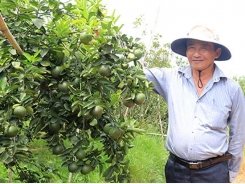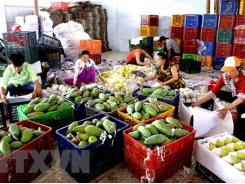To escape the trap for cashew industry

After many years of development and leading the world in cashew nut exports, Vietnam cashew industry has exposed many shortcomings that need to be quickly removed.
Raw cashew nut accounts for 95% of the cashew nut export structure of Vietnam. Photo: N.Hien.
Inadequate in all stages
Minister of Agriculture and Rural Development – Mr. Nguyen Xuan Cuong, said that in the past 30 years, the cashew industry has become a key industry in agricultural products with the total production in 2017 reached 353,000 tons, reaching the export value of 3.52 billion USD. Through this result, the cashew industry has created jobs for about 1 million people, including cashew growers and cashew workers, and brought foreign currency to the country.
However, Mr. Cuong pointed out that Vietnam cashew industry is showing many weaknesses and inadequacies. Accordingly, in the area of cultivation, this is the only industrial plant that has been reduced from 440,000 hectares in 2008 to only 300,000 hectares so far. In addition, in terms of productivity and economic efficiency for farmers, cashew is a crop that brings low income for them. Meanwhile, the situation of severe climate change, especially the unpredictable off-season rain, has affected the rate of flowering, fruiting and the strong growth of two groups of specific pests: anthracnose and tea mosquito bugs, thereby inhibiting the productivity of cashew. This leads to low efficiency for cashew growers. "If this problem is not overcome, the area of cashew cultivation will continue to decline, then Vietnam will have to depend entirely on imported raw materials", Mr. Cuong emphasized.
In terms of processing, despite having established a cashew processing industry with more than 400 enterprises, Vietnam’s cashew industry still produces only the final material of the seed segment, which is white cashew nut. With deeper, higher added value products, Vietnam only finishes about 5%. While the production and processing sector accounts for only more than 40% of the value chain, and the Vietnamese cashew industry cannot handle the processing and distribution sector. This is also the bottleneck leading to the fact that the overall efficiency of this chain is not high.
According to the report of the Department of Crop Production – Ministry of Agriculture and Rural Development, Vietnam now has more than 465 cashew processing enterprises with a total capacity of over 1.4 million tons of nuts/year. In terms of processing capacity, enterprises with large capacity have occupied more than 70% of production. However, in terms of quantity, the number of small processing establishments still accounts for nearly 70% (314 units). In which, there are about 20 big companies investing in deep-processing products such as: roasted salted cashew nut, fried butter cashew nut, condiment cashew nut, mixed cashew nut, confectionery from cashew,… with a capacity of 15.4 thousand tons products/year, the rest are small establishments, supplying the domestic market about 20,000 tons of products/year. About processing cashew nut shell liquid, there are 26 facilities with a capacity of 80,000 tons of products/year and 5 oil seed processing facilities with a capacity of 6,000 tons of products/year.
Mr. Nguyen Duc Thanh, chairman of the Vietnam Cashew Association stated that the quantity of Vietnam processing enterprises of cashew nuts in Vietnam is large, but most of them are small. The largest exporter of cashew nuts in Vietnam in 2017 only reached about 170 million USD. While the turnover of foreign enterprises amounted to billions of USD. "Although there are more than 400 export enterprises and 1,000 processing plants, most are super-small enterprises, their turnover each year is only a few hundred thousand USD, only a few dozen companies have turnovers of over 30 million USD/year” - said Mr. Thanh.
Rushing to restructure
In the face of such inadequacies, Minister Nguyen Xuan Cuong suggested that the cashew industry should focus on the restructuring of the cashew industry with a number of major views and objectives. Accordingly, from now to 2030, there will be no increase in cashew plantation area, because the current land fund for crops is at a relatively balanced level at 300,000 hectares and remains stable. But it is important to focus on the value chain, in which productivity should be increased to the appropriate level. Specifically, Vietnam cashew industry is still abundant to increase productivity by 1.5 or 2 times, so it is necessary to focus on building adaptation processes for each of the key sub-regions, including the South East, Central Highlands and South Central. Along with that, focus on deeper processing, accompanied by the need to build strong brands to ensure a longer value chain in the future. It also needs to study the advances in science and technology to overcome the unfavorable elements of the weather. For example, with the off-season rain problem, there should be a variety of species suitable for each sub-region, or there must be a process to have the farming methods to overcome the epidemics such as anthracnose and tea mosquito bugs…
Mr. Cuong also emphasized the issue of reorganizing production, forming closed production chains with close links from production to processing and trade. To do that, enterprises have to closely associate with farmers with the method of forming cooperatives to organize production, apply science and technology, stabilize the purchasing, processing and developing market. In particular, regarding the market development, we must pay attention to both domestic and foreign markets. "The domestic market has not received enough attention recently while this is one with the most potential and advantageous markets for commercial stability. Excessive dependence on foreign markets will lead to distortions, inadequacies, and inadequate exploration of the value chain. Moreover, the growth of tourism in Vietnam is up 30%/year, so this is one of the great potentials for on-spot export", Mr. Cuong said.
Nguyen Duc Thanh, Chairman of Vietnam Cashew Association:
In the export structure of Vietnam cashew industry, the raw cashew nuts now account for 94-95%, while processed products account for only 5%. Deep processing increases the export value by at least 20%. This is an opportunity but also a challenge for our processing plants. Currently, the price of processed cashew nuts is being sold by supermarkets in the US and Europe at over 20 USD/kg, while the export price of cashew nut processed by Vietnamese enterprises is only about 10 USD/kg. As a result, the cashew industry must reorganize in a closely linked production chain from production to export to improve the value of cashew nuts on the world market.
Mr. Ta Quang Huyen, Director of Hoang Son 1 Company:
Vietnam has too many enterprises processing and exporting cashew nuts. This led to a scramble for buying raw materials as well as selling cashew nuts. In addition, the quality of products is uneven and the risk of unsafe food hygiene, which affects the reputation of Vietnam cashew in general. Therefore, the State should pay attention to the issue of building the national brand to improve the prestige of cashew, thereby supporting the marketing and promotion of cashew nut products.
Có thể bạn quan tâm
Phần mềm

Phối trộn thức ăn chăn nuôi

Pha dung dịch thủy canh

Định mức cho tôm ăn

Phối trộn phân bón NPK

Xác định tỷ lệ tôm sống

Chuyển đổi đơn vị phân bón

Xác định công suất sục khí

Chuyển đổi đơn vị tôm

Tính diện tích nhà kính

Tính thể tích ao hồ



 Vietnamese farm produce seeks to reach French customers
Vietnamese farm produce seeks to reach French customers  Tien Giang expands fruit production as prices rise
Tien Giang expands fruit production as prices rise